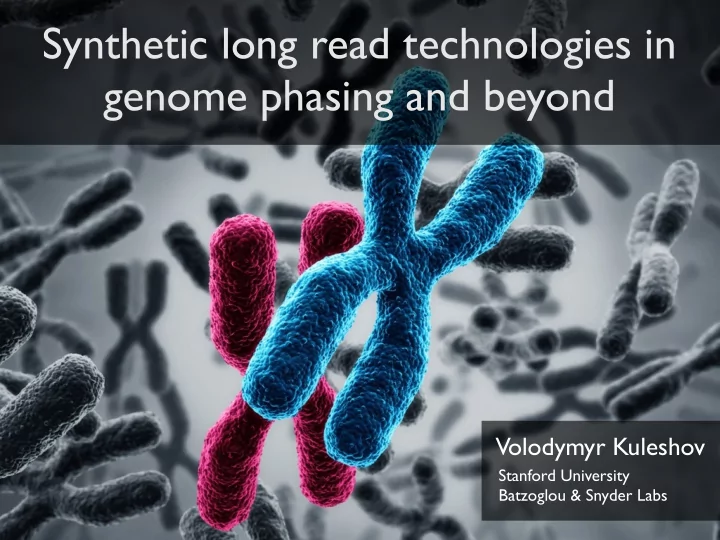

Synthetic long read technologies in genome phasing and beyond Volodymyr Kuleshov Stanford University Batzoglou & Snyder Labs
+ Latest ongoing research on synthetic long reads
Genome phasing ----- [A/T] ------ [C/G] ----- [G/T] ------ ----- [A] ------ [G] ----- [G] ------ ----- [T] ------ [C] ----- [T] ------ Fundamental aspect of human genetics that is relevant in many applied problems
Scientific application Allele-specific methylation Differentially methylated Paternal and region maternal methylation levels TF factor binding site
Medical application HLA typing • Immune response during organ transplantation depends on compatibility between HLA genes • These genes are highly heterozygous
General principle unphased ----- [A/T] ------ [C/G] ----- [G/T] ------ genome ----- [A] ------ [G] ----- ------ [C] ----- [T] ------ sequence reads ----- [T] ------ [C] ----- ----- [A] ------ [G] ----- [G] ------ phased result ----- [T] ------ [C] ----- [T] ------
Long read sequencing • Phasing is now becoming possible thanks to new synthetic long read technologies • Examples: Moleculo, Long Fragment Reads (LFR), 10X Genomics • Produce virtual multi-kb reads on regular sequencers
A 1. Moleculo starts with quality DNA 2. DNA is cut into 10 Kbp fragments The fragments are placed into wells 3. Wells are assigned a unique barcode 4. The contents of each well are sequenced with short reads and 5. reconstructed on a computer
Locally phased blocks 3. + • Phasing as inference in a probabilistic model (ECCB14) • 11% more accurate than RefHap • Produces useful confidence scores
Shortcomings • Reads too short relative to other methods • 10% of variants unphased due to sequencing bias Moleculo LFR 600 Kbp N50 60 Kbp 95% % phased 90%
Idea: Use statistical phasing!
Prism Statistical Phaser • Extends earlier methods to handle pre-phased 3. blocks • Prior information from + blocks significantly improves accuracy 4. • Works best where molecular phasing fails 5. • Produces useful confidence scores
Prism Statistical Phaser 3. • Augments the HMM model of Li and Stephens (used in + Impute2, Shape-IT, etc) with additional variables 4. • Determines scores using probabilistic inference in the model 5.
Experiments 500 Kbp N50 < 1 error/Mbp Haplotype block Phasing rate Switches N50 length (bp) over SNVs per Mbp NA12878 (two libraries) 563,801 99.00% 0.47 NA12891 (two libraries) 647,599 99.25% 0.68 NA12892 (two libraries) 531,804 98.84% 0.75 NA12878 (library #1) 401,342 98.49% 0.51 99% of SNVs phased
Comparison This shows how clever algorithms can greatly improve sequencing technology
Metagenomics • We used Moleculo to assemble the human gut microbiome, which led to: • Very long contigs • High resolution analysis of strains • Enabled by new software package called Nanoscope
Assembly results • 650 Mbp of sequence as 50 Kbp (N50) contigs (7x longer than with Illumina) • Several megabase-long contigs, including a recently discovered species
Sub-strain identification
Sub-strain identification • A A T G T C A Lens phasing algorithm a. G T C A A T T reconstructs bacterial haplotypes. assembly assembly assembly A T C G C T • T C T C Over 200K variants b. T A G A T A T A • G T C Haplotype N50 length of 22 Kb etection ection etection • Several long haplotypes A T C G T C T c. G A T A T A of over 120 Kbp G T C
De-novo Assembly A R B C R D Two regions with repeat R covered by long reads A D Repeat structure in the R assembly graph C B A D Resolving the repeat using R raw short reads C B
Conclusion • Synthetic long reads are a promising sequencing technology that can make progress on important genomics problems • This technology requires developing novel computational methods, which opens a new research direction
Acknowledgements • Snyder Lab: Mike • Funding Agencies Snyder, Dan Xie, Chao Jiang, Wenyu Zhou • NIH Training Grant • Batzoglou Lab: • NSERC Canada Serafim Batzoglou, Alex Bishara, Yuling Liu Graduate Fellowship • Moleculo Team: • ISCB for travel support Dmitry Pushkarev, Michael Kertesz,Tim Blauwkamp
Thank you!
Recommend
More recommend